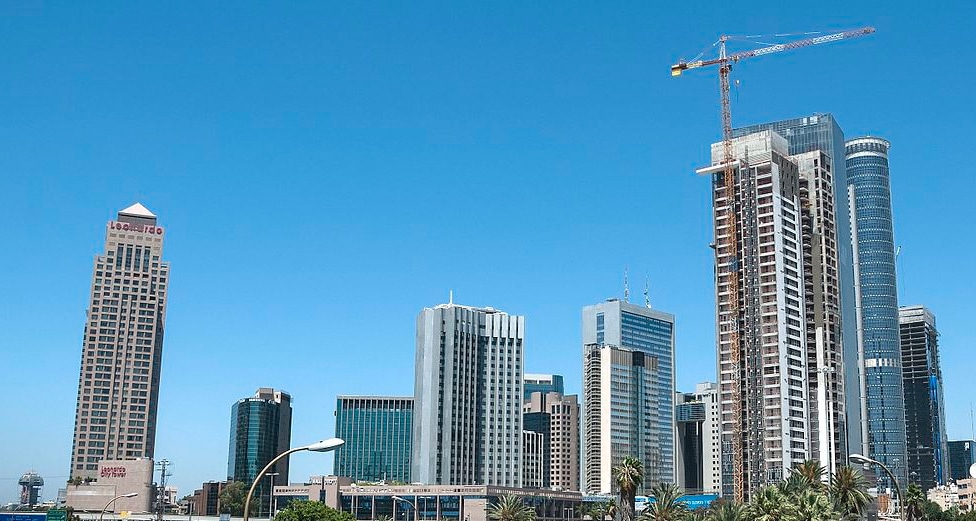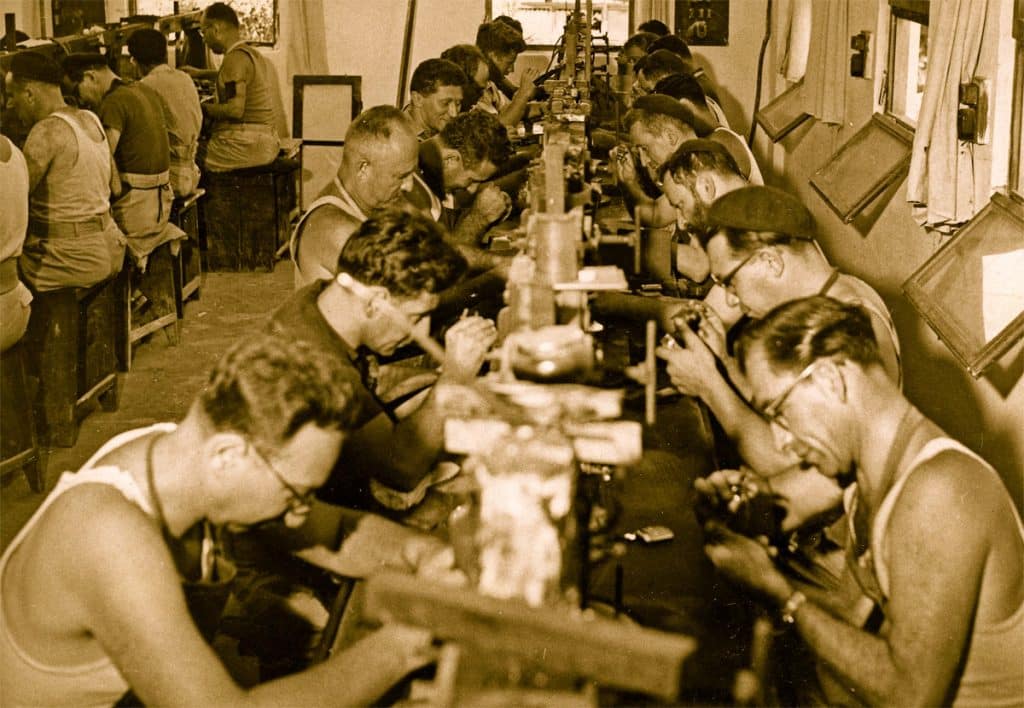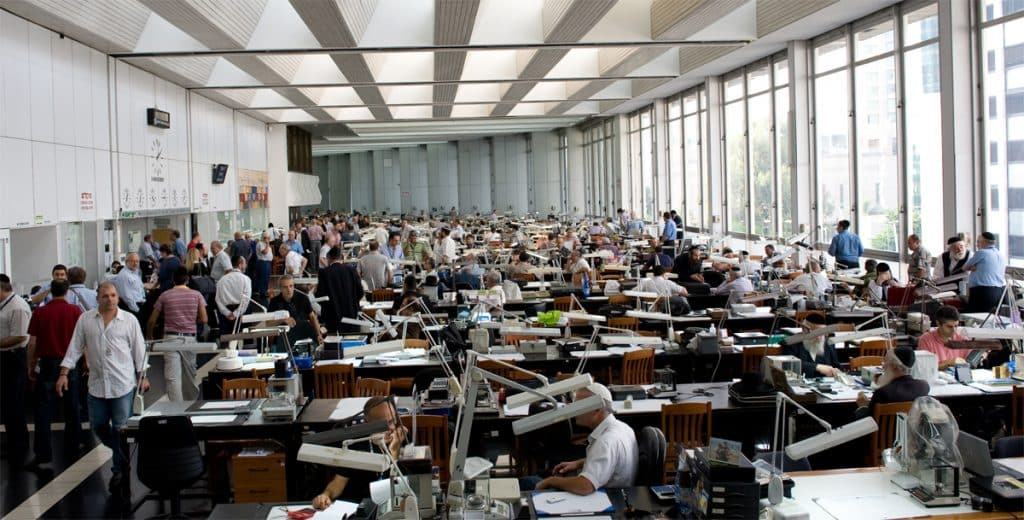Blog
Home » Diamonds blog » THE STORY OF ISRAEL’S DIAMOND INDUSTRY IS THAT OF THE COUNTRY
Focus on

Ramat Gan’s ‘Bourse’ business district, home and headquarters of Israel’s giant diamond complex.
With net exports of rough and polished diamonds equaling $7.4 billion in 2016, and serving as the primary supplier of the gemstone to the world’s largest market, the United States, Israel is among the global industry’ primary movers and shakers. Also in 2016, MID House of Diamond was ranked by Israel’s Ministry of Economy as the country’s first-ranked diamond exporter, with polished diamond sales worth $186 million.
The history of the Israeli diamond center mirrors the remarkable story of Israel. Just 100 years earlier, what is today a densely-packed business district of metal and glass skyscrapers was largely open fields. The cities that surround it, Ramat Gan and Tel Aviv, were essentially villages.
It all began in 1932, when a group of Belgian Jews immigrated to what was then the British Mandate of Palestine, with the intention of establishing a diamond-polishing plant. They lobbied the authorities to waive duties levied on imported rough diamonds, and these efforts eventually proved successful in 1936.
The original polishing plant imitative was unsuccessful, but the British acquiescence to allow the customs-free import of rough led to the establishment of a number of rudimentary polishing plants in Tel Aviv, mainly by Belgian and Dutch immigrants. In 1937 the first fully-fledged diamond factory was set up in the nearby town of Petah Tikva. That same year, the first trade association, the Palestine Diamond Club, was founded in Tel Aviv.
Following Nazi Germany’s occupation in 1940 of Holland and Belgium, the diamond plants in Amsterdam and Antwerp fell silent. In an effort to keep the business afloat, De Beers pushed for the growth of alternative manufacturing centers, among them pre-state Israel. In Tel Aviv, Petah Tikvah and a new cutting center in Netanya, the number of workers employed in the industry rose to some 4,000 people, and by the end of the war exports of polished diamonds stood at about $16 million.
But with the return of peace of Europe, the supply of rough diamonds to the fledgling cutting centers dried up, as De Beers fulfilled a promise to support Antwerp’s struggle to revive its dormant industry. Nonetheless, although the number people employed in the cutting factories of Tel Aviv, Petah Tikvah and Netanya was more than halved, the nucleus of a diamond industry remained.
Two years following the establishment of the modern State of Israel in 1948, De Beers began regular sales of rough diamonds to Israeli factories, and the long-term future of the industry was secured.
The Israel Diamond Exchange was formally established in 1951 in rented quarters in Tel Aviv. Today, with about 3,100 members, it is the world’s largest diamond bourse.
The center in the adjacent city of Ramat Gan came to be after industry leaders understood a permanent trading facility was needed to serve the requirements of the growing trade. After some deliberation, a plot in Ramat Gan was selected as the permanent site for the Israel Diamond Exchange, and in 1968 the Shimshon Building was inaugurated, providing some 15,000 square meters of office and commercial space.
The concept devised for the new trading complex was revolutionary. What was planned was a secure unit, in which all services would be provided within a single perimeter, enabling diamantaires to move around freely and securely. This included the diamond trading floor and bourse offices, government representatives, banks, shipping companies, insurance companies and restaurants.

A diamond factory in Tel Aviv during the 1940s. The new manufacturing center in pre-state Israel was able to compensate for the loss of production from the traditional cutting centers in Amsterdam and Antwerp, which were under Nazi occupation.

The trading floor of the Israel Diamond Exchange in Ramat Gan. About the length of two football fields, it is the world’s largest such facility.
As more buildings were added to the complex – Maccabi and Noam in the 1980s and Yahalom in the 1990s – bridges and walkways were constructed to connect them, meaning diamantaires could move from building to building, without leaving the secure zone. Today the complex covers an area of about 80,000 square meters, housing approximately 1,050 diamond company offices. The trading floor of the Israel Diamond Exchange, the world’s largest, is located on the bridge that straddles the Shimshon and Maccabi buildings.
Among the tenants in the complex is the country’s second bourse, the Israel Precious Stones and Diamonds Exchange, which was established in 1979, setting up offices and a separate trading floor in the Maccabi building. It is one of only a handful of bourses that specializes in the trade of colored gemstones.
The evolution of the Israel’s diamond industry reflects that of the nation’s economy in general. The Jewish state began life as an economic backwater, with no natural resources to talk of, an ongoing conflict on all of its borders, and a population that more than doubled over a three-year period, as Jewish refugees flowed in from war-ravaged Europe and from Arab countries in North Africa and the Middle East.
Over the 68 years of the Jewish state’s independence, the country’s diamond exports grew by a multiple of more than 1,200.
As Israel was transformed from a country with a developing economy into one with an advanced economy, a large portion of manufacturing capacity shifted to other countries, most notably India, but later China as well. But the country remains home to large number of manufacturers, but many of them are operating internationally, owning or outsourcing to factories in other countries. Goods that are cut and polished in Israel are predominantly of higher value, where the cost of labor is less of a factor and the quality of the workmanship is of paramount importance.
Israel is a country that historically has had to make do without a wealth of natural resources. Its impressive economic accomplishments are almost entirely due to its most valuable national asset, its human capital. The same certainly is true of its diamond industry.

Diamond traders on the floor of the Israel Diamond Exchange.
